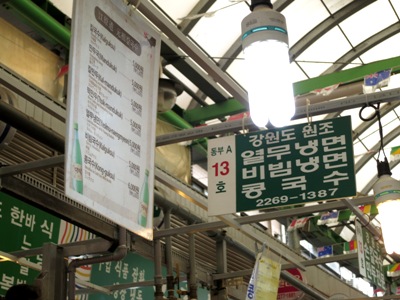This post was first posted at
Street Food at Gwangjang Market (광장시장) ~ Jongno-gu on Deliciouslogy | Wordpress.
Gwangjang Market, formerly known as Namdaemun Market is one of the best places to look for snack food and food souvenirs such as seaweed or citron tea. Since it's a wet + dry market, you'd also find traditional hanbok and clothes alongside fresh fish and vegetables.
Our main purpose here was to sample Korean street food and whatever else we found on the way would be a plus point.
If you're a fan of pig's blood cubes, Korea has their version called sundae, pronounced 'soon-day' and not 'Sun-day'. It's a kind of blood sausage that my travel mates and I do not like so we skipped it all together. You can see it in it's uncooked form next to the old lady in the photo.
First up - mini kimbap and tteokbokki.
Kimbap and tteokbokki go hand in hand here and all kimbap sellers will have a tray of tteokbokki simmering as well. The tteokbokki is simmered in a sweet and mildly spicy sauce and topped with toasted sesame seeds. The chewy texture of the rice cakes and the savory sauce makes it a tasty, widely popular snack. It's probably the most common snack in Seoul as you'll find a tteokbokki stall anywhere.
The kimbap had simple ingredients of cooked carrots and danmuji rolled in seasoned rice. A nice, clean tasting treat alongside the tteokbokki. The yellow paste served with the kimbap is gochu-naengee, a Korean version of wasabi paste. Dip the kimbap sparingly as it is just as strong as the Japan counterpart.
Also, sikhye, a traditional sweet Korean rice beverage is commonly sold by kimbap and tteokbokki sellers. The drink tastes a lot like barley water.
There were so many sellers selling the exact same thing that we randomly pointed at one to decide which one to eat at.
If you have the stomach for it, there's live octopus served at Gwangjang Market.
While walking about, we spotted a hotteok (prononuced hot-tok) stall.
The filled pancakes are fried till golden brown and flattened.
Hotteoks resting before being served.
This savory japchae filled hotteok gets a light coat of sweet and spicy glaze.
Something that seemed so simple had lots of flavor and different textures. Sweet, tangy, salty flavors and textures of crispy and chewy all in one.
We loved every bit of this japchae hotteok. If you come across stall no. 40, do give it a try.
Bibimbap in a traditional setting is so colorful! Because we wanted to try mandu, we didn't try this.
After walking pots of simmering pots and piles of mandu everywhere, we settled on stall no. 13.
They have English translations of the menu which was great.
The simple setting of the stalls are usually made of a table top which has multiple functions as a chopping board area, storage area and dining area and long heated benches. Yes, heated. See that white cord? It's literally a butt warmer.
Help yourselves to some mild tasting tea.
For side dishes, you get a stir fried leafy vegetable and... kimchi.
There were 2 varieties of mandu - a plain skin dumpling
A kimchi dumpling with 2 different kinds of skin.
The normal dumpling is stuffed with mashed tofu and lots of leek. I can still remember the taste of the leek with a shudder. The taste was overpowering and the bland tofu made the leek flavor the main star. It was very hard for me to eat them so I ended up dousing them with chili sauce. It's in the photo with the metal cups. The chilli sauce was slightly tangy and salty so it helped a little, just a little.
The kimchi dumplings was the normal variation with added kimchi. It was like a double blow for me. Garlicky kimchi and the strong flavor of leek. The kimchi in the mandu tasted the same as the one they served to you as a side dish.
I ended up struggling through all 3 varieties of mandu, including this slightly darker variation. It's probably made of a buckwheat flour that gives it that brownish appearance.
I was not fond of the mandu I ate at the Gwangjang Market but despite all that, the mandu was quite finely made. The skin was quite translucent and not too thick and the seaweed soup it was served in, warm and tasty.
Directions to Gwangjang Market is available at the Visit Korea website.
---
Here's a summary of what we ate during our trip, click the image below for a larger view.
Kindly compiled by my extremely efficient travel finance manager, the excel sheet for the above image is available here.

























